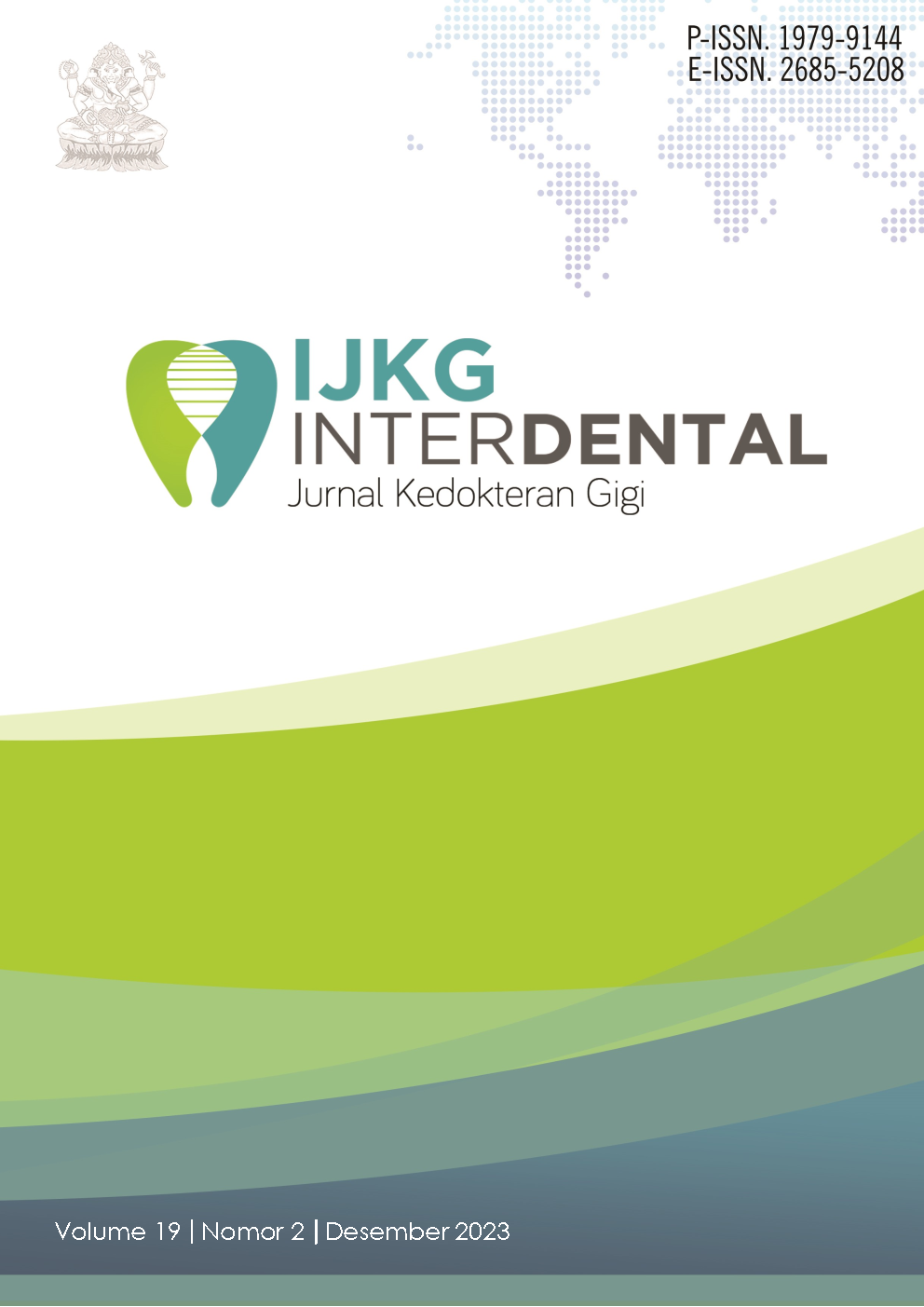MINIMAL INVASIVE FOR MAXIMAL RECOVERY IN DENTAL TRAUMA : A CASE REPORT
DOI:
https://doi.org/10.46862/interdental.v19i2.7833Keywords:
Dentoalveolar fracture, Mobilization tools, SplintingAbstract
Introduction: Dentoalveolar fractures can be treated in a simple non-surgical procedure by repositioning the fractured fragments and immobilizing them. One of the factors affecting the success of dentoalveolar fracture treatment is the choice of material and immobilization technique.
Case: A 16-year-old girl came to the Emergency Department with complaints of bleeding from the mouth due to a traffic accident 5 hours ago. Her lip hit the handlebar of a motorcycle. There was no history of fainting, vomiting, and bleeding from the ears and nose. Extraoral examination revealed an asymmetrical face. Edema and laceration on the upper lip. Intraoral examination revealed gingival laceration of teeth 12-22 and avulsion of teeth 12,22. Panoramic x-ray revealed supra position of teeth 11, 21 and avulsion of teeth 12, 22.
Case Management: Wound debridement, indirect root canal treatment of teeth 12, 22, repositioning of teeth 12-22, fixation with wire and composite splinting, selective grinding, antibiotics, and analgesics were performed. Post-operative instructions included maintaining oral hygiene, a soft diet, and a return for splinting control.
Discussion: The goal of dentoalveolar trauma treatment is to restore the normal function and shape of the masticatory organs. The treatment in this case uses flexible splinting because it has ability to resemble the physiological mobility condition of the teeth which can help the healing of the periodontal ligament. The treatment results showed soft and hard tissue healing after one month of treatment.
Conclusion: Successful treatment of dentoalveolar fractures will be achieved if performed promptly and if accurate immobilization and accurate tools are used. Simple tools and techniques make flexible splinting a good treatment for simple dentoalveolar fractures.
Downloads
References
Council on Clinical Affairs (2012). Guideline on Management of Acute Dental Trauma. American Academy of Pediatric Dentistry. Clinical Guidelines; p.230-238.
Pastor BS, et al (2016). Treatment and Restoration of Adult Dentoalveolar Trauma: A clinical Case Report. J Clin Exp Dent; 8(5):634-647
Fonseca RJ, Walker RV, Betts NJ, Barber HD (2005). Oral and maxillofacial trauma. Vol.1. 3rd ed. Philadelphia: W.B. Saunders Co.
Anthony J (2012. International Association of Dental Traumatology Guidelines for The Management of Traumatic Dental Injuries : 1. Fractures and Luxations of Permanent Teeth. Dental Traumatology; 28(3):2-12.
Peterson LJ (2003). Contemporary oral and maxillofacial surgery. 3rd ed. St. Louis. Livingstone.
Andersson L. et al (2012). International Association of Dental Traumatology guidelines for the management of traumatic dental injuries: 2. Avulsion of permanent teeth. Dental Traumatology; 28: p88–96.
Kahler B., et al (2016). Splinting of teeth following trauma: a review and a new splinting recommendation. Australian Dental Journal; 61:(1 Suppl) p.59–73.
Berthold C., Thaler A., Petschelt A (2009). Rigidity of commonly used dental trauma splints. Dental Traumatology; 25: p248-255.
Mazzoleni S. et al (2010). In vitro comparison of the flexibility of different splint systems used in dental traumatology. Dental Traumatology; 26: p30–36.
Samsudin E (2007). Immobilization Tools and Materials Selection in Dentoalveolar Fracture. Padjadjaran Journal of Dentistry; 19(3):119-124
Oikarinen K. Tooth Splinting (1990) : A Review of The Literature and Consideration of The Versatility of A Wire-Composite Splint. Endod Dent Traumato. Finlandia.
Croll TP (1991). Bonded Composite Resin/Ligature Wire Splint for Stabilization of Traumatically Displaced Teeth. Quintessence International; 22(1):17-21.
Oraie E. Et al (2012). Apical Sealing Ability of MTA in Different Liquid to Powder Ratios and Packing Methods. Iranian Endodontic Journal; 7(1):5-9
Downloads
Published
How to Cite
Issue
Section
License
Copyright (c) 2023 Anak Agung Manik Swayoga, Ilma Yudistian

This work is licensed under a Creative Commons Attribution-ShareAlike 4.0 International License.
- Every manuscript submitted to must observe the policy and terms set by the Interdental Jurnal Kedokteran Gigi (IJKG)
- Publication rights to manuscript content published by the Interdental Jurnal Kedokteran Gigi (IJKG) is owned by the journal with the consent and approval of the author(s) concerned.
- Full texts of electronically published manuscripts can be accessed free of charge and used according to the license shown below.













